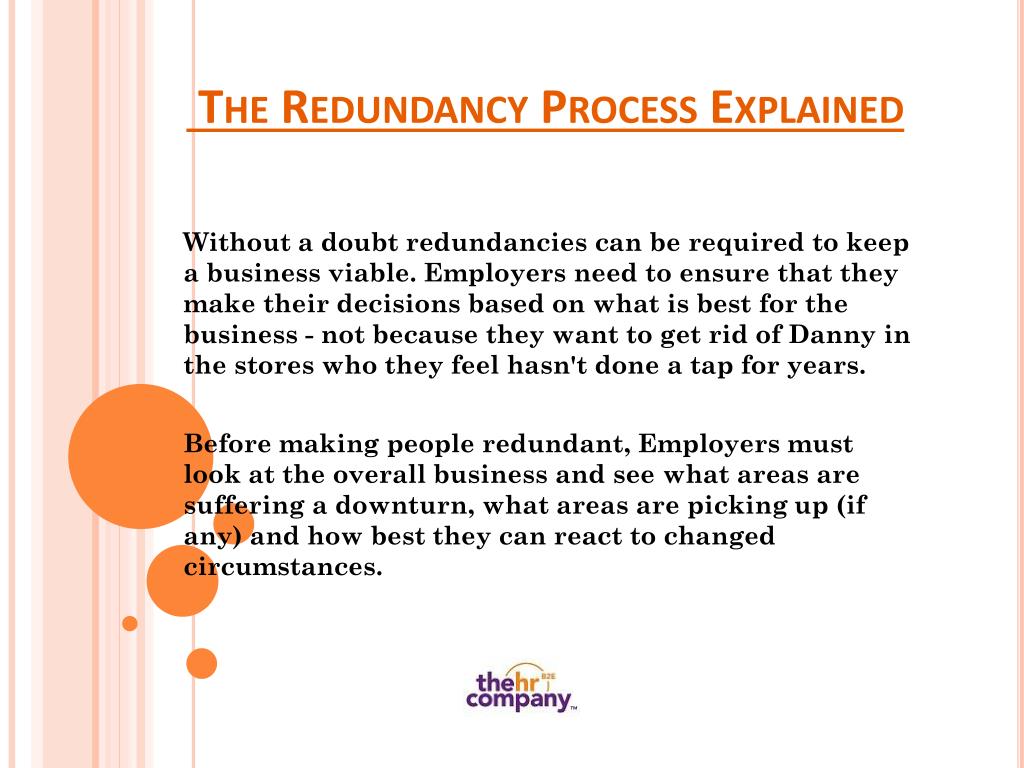Small Business Closing Employee Rights UK: Ensuring Fair Redundancy Pay
Small Business Closing Employee Rights UK: Ensuring Fair Redundancy Pay
Blog Article
Examining the Interplay Between Firm Redundancy and Organizational Versatility for Future Growth
In the vibrant landscape of today's organization world, the elaborate connection between firm redundancy and organizational adaptability arises as a vital factor for continual development and success. Firms typically face the obstacle of striking a fragile balance in between maintaining a level of redundancy to alleviate risks and promoting flexibility to respond swiftly to the ever-evolving market demands.
Importance of Business Redundancy
Firm redundancy is an important element that enhances organizational resilience and mitigates functional dangers. By integrating redundancy measures within the business framework, business can much better hold up against unforeseen disturbances and fluctuations in the business atmosphere. Redundancy works as a critical buffer, enabling business to adapt and respond properly to unforeseen obstacles without endangering vital operations.
One secret element of the significance of business redundancy is its function in guaranteeing connection during times of dilemma. When faced with sudden modifications or emergencies, repetitive systems, resources, or workers can action in to maintain crucial functions and protect against prevalent disturbances. This continuity not just safeguards the firm's reputation and consumer count on but likewise reduces monetary losses and functional downtime.

Techniques for Business Flexibility

Another important technique is buying modern technology and framework that can sustain flexibility and scalability. Executing digital tools, automation, and information analytics can simplify procedures, boost effectiveness, and give beneficial insights for educated decision-making. Moreover, developing adaptable business frameworks that enable for fast adjustments to market dynamics and consumer needs is essential for remaining affordable in a quickly progressing environment. By proactively identifying potential interruptions and chances, organizations can proactively grow and adapt in an ever-changing organization landscape.
Balancing Redundancy and Flexibility
Attaining an unified balance between functional redundancy and business versatility is paramount in browsing the complexities of a vibrant service setting. Redundancy within a business provides a safety and security net, making sure continuity and security in operations. Nonetheless, an unwanted of redundancy can result in inadequacies and prevent versatility go to this web-site to changing market conditions. On the other hand, business adaptability enables firms to respond quickly to exterior interruptions and confiscate brand-new chances. Striking the best balance in between redundancy and flexibility is a delicate process that calls for a deep understanding of the company's objectives, market dynamics, and threat tolerance.
To accomplish this equilibrium, business need to carry out routine evaluations of their operations to recognize areas where redundancy is essential for threat mitigation and where adaptability can drive innovation and growth. Applying flexible frameworks, fostering a culture of continuous learning and renovation, and motivating open interaction across all degrees of the company are crucial techniques to balance redundancy and adaptability successfully. By aligning these 2 critical elements, firms can place themselves for lasting growth and success in an ever-changing company landscape.
Study on Adjustment Success
In checking out circumstances of successful organizational adjustment, it comes to be obvious that the interplay in between operational redundancy and adaptability is a defining aspect in forming resilient services. One engaging instance study is that of Netflix. Initially a DVD rental solution, Netflix showed impressive flexibility by transitioning into a streaming platform visit the website when digitalization disrupted the sector. By tactically investing in technology and material production, Netflix not just grew however made it through in a rapidly developing market. Another standout example is Amazon. Starting as an online book shop, Amazon continually adapted its organization model, expanding into diverse sectors such as cloud computer and fabricated intelligence. This versatility enabled Amazon to remain in advance of competitors and satisfy altering customer demands. Last but not least, Adobe gives a noteworthy illustration of successful adjustment. The firm moved from offering software program licenses to a subscription-based model, guaranteeing repeating income streams and enhanced client involvement. These case studies emphasize the importance of functional redundancy combined with organizational versatility in cultivating long-lasting development and competition.
Structure Durability for Future Growth
Building durability for future development requires a critical alignment of functional procedures with market dynamics and arising trends. Business have to adjust to changing settings by fostering a society of versatility, advancement, and constant enhancement.
Additionally, fostering strong relationships with stakeholders, such as consumers, staff members, vendors, and the area, is crucial for weathering uncertainties and keeping trust and assistance during stormy times. Effective communication and openness play a vital role in building strength, as they aid align expectations and assist in collaboration in navigating unpredictabilities.
Additionally, companies require to prioritize knowing and growth initiatives to upskill staff members and furnish them with the necessary tools to adjust to altering circumstances. look at this site By buying their workforce, firms can improve their versatility and dexterity, eventually reinforcing their resilience for sustainable future growth.
Final Thought

In the dynamic landscape of today's organization world, the detailed relationship between business redundancy and business adaptability emerges as a vital aspect for sustained development and success. Business commonly encounter the challenge of striking a fragile balance between preserving a degree of redundancy to reduce dangers and fostering adaptability to respond swiftly to the ever-evolving market needs.To achieve this equilibrium, firms need to carry out regular analyses of their procedures to identify areas where redundancy is needed for danger mitigation and where versatility can drive advancement and development.In verdict, the interplay in between company redundancy and organizational flexibility is essential for future growth. Building durability with a combination of redundancy and versatility will certainly guarantee that firms are prepared for the difficulties of the future.
Report this page